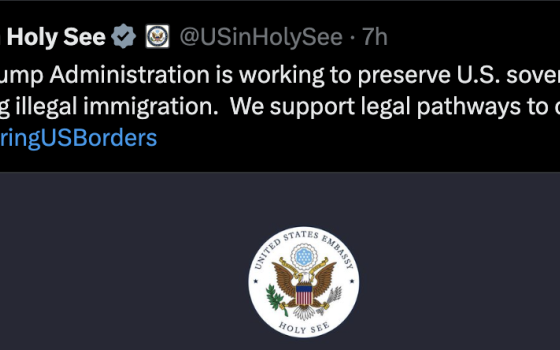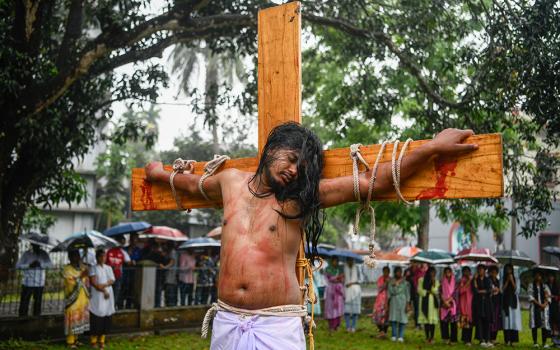On November 16, 1953, Cardinal Edward Mooney, the Archbishop of Detroit, invited Father John Courtney Murray, S.J. to dinner with Cardinal Samuel Stritch, the Archbishop of Chicago. The men discussed Murray’s theological efforts to develop the Church’s doctrines regarding Church-State relations. In a letter to his friend, and my mentor, Msgr. John Tracy Ellis recounting the evening, Murray wrote that at one point in the evening, Cardinal Mooney said “None of us could go as far as Gibbons went.” Murray commented to Ellis that he “was dying to ask: ‘Why not?’”
Since I first learned of this historical moment in the late 1980s, much has changed in my worldview. Then, under Ellis’ tutelage, I was convinced that Murray’s efforts were incontrovertible; now, I see difficulties with Murray’s theological presuppositions. Then, I knew only a handful of bishops; now, I know two handfuls. Most importantly, I have come to learn that the explanatory value of the idea that the Romanization of the U.S. hierarchy is the heart of the problem is more complicated than I thought back then. Earlier in that year of 1953, Ellis had written to Murray, “Something fine and bracing has gone out of the American Church and it is difficult to see how it can ever be regained.” But, I have since come to know some bishops who are “fine and bracing.”
The Romanization of the American hierarchy began in earnest in 1901, with the appointment of William Henry O’Connell as the Bishop of Portland, Maine. Back then, of course, there was yet no universal code of canon law. America had only received its first Apostolic Delegate in the previous decade. In the U.S., when a diocese became vacant, the irremovable rectors of the diocese (there were yet no canonically designated pastors) would gather and draw up a terna, a list of three names, to fill the vacancy. Then, the bishops of the ecclesiastical province would gather and also draw up a terna. In the case of a vacant archdiocese, the U.S. archbishops would also draw up a list. All this was sent to the Congregation for the Propagation of the Faith (the U.S. was still considered mission territory), and they would compare the ternas, draw up their own, and the Pope would make the final choice. In 1901, the priests of Portland and the bishops of the Boston province agreed on the same three names, but not in the same order. Additionally, the administrator in Portland wrote to Rome indicating that the terms of office of the irremovable rectors, or “consultors,” had expired, so their terna was invalid. After some back and forth, the cardinals of Propaganda Fide set the ternas aside entirely and choose the rector of the North American College, William Henry O’Connell, for the post. Five years later, O’Connell connived to have himself named coadjutor Archbishop of Boston, with the cardinals of Propaganda again ignoring the ternas sent from the U.S.
Thus began the elimination of the tradition of the Church in the U.S. of soliciting direct input from the clergy and other bishops in the selection of bishops. Throughout the twentieth century, the selection of bishops became centered in the nunciature in Washington, or in the hands of powerful U.S. cardinals with good Roman contacts. The process has always been susceptible to influence peddling and internal bickering nor is it difficult to see how this process could produce more pliable bishops. For example, Cardinal Spellman had no use for the Apostolic Delegate Archbishop Cicognani, but because of his close relationship with Pius XII, Spellman was able to see many of his friends elevated to the episcopacy. Cicognani took a liking to Bishop Hoban of Cleveland and, in the post-war era, Cleveland became a “bishop factory,” producing such future luminaries as Cardinal Dearden, Cardinal Krol, Bishop Begin, Bishop Treacy, Archbishop Hallinan and Archbishop Whealon. As you can see from just that list, Dearden, Krol, and Hallinan were all strong figures, and while some would think them “fine” and others less than fine, there is no doubt they could be “bracing.” As well, the idea that Romanization has led to a certain infantilization of the hierarchy seems overwrought: This past week, several bishops took to the microphones at the ballroom in Baltimore and spoke forcefully. Nonetheless, what is discernible, and clearly a result of the Romanization of the hierarchy, I think, is a distance between the hierarchy and the rest of the U.S. Church. Some bishops overcome this because of the way they conduct themselves as bishops, they spend time with their people and with their priests, they would not seem out of place walking into a Dunkin’ Donuts or a Shoney’s for a morning coffee and yucking it up with the other patrons. But, they know, they all know, that the good people lined up for coffee, and indeed their own clergy, played no role in their selection and that to the extent they are accountable, it is to Rome.
In some instances, this accountability to Rome is a very good thing. During the meeting this week, Bishop Boyea of Lansing suggested that the Acton Institute be brought on as a consultant to one of the USCCB’s committees – Bp Boyea said the international committee, but I think he meant to say the domestic policy committee. Either way, his suggestion makes the case that an idea is not a priori better because it is indigenous. In Rome, they can spot the difficulties with the libertarian sensibilities of the Acton Institute – they have been spotting them for more than 120 years now, and not only spotting but denouncing. There were in the ballroom in Baltimore several bishops who clearly have been watching too much Fox News, when they should have been reading Rerum Novarum, Quadragesimo Anno, Populorum Progressio and Caritas in Vertate, all of which warn against the danger of laissez-faire economics of the kind peddled by the Acton Institute and, evidently, imbibed by the Bishop of Lansing. I suspect, too, that there are officials in Rome who are more than a little nervous about the efforts by some U.S. bishops to baptize the First Amendment: You see, I am not the only person who has developed reservations about Murray’s work! And, on an issue like climate change, Rome is so far out ahead of the U.S. – not just the Church but the society as a whole – that we must resist any facile conclusions about Roman influence being nefarious per se.
There is certainly much to be said for a certain cautiousness on the part of anyone charged with exercising the authority of the Magisterium: Souls are at stake and mistakes are consequential. But, I wonder if that is the cause of the cautiousness. Very few young bishops took to the microphones this week. Have they nothing to say? In this new generation of bishops, many of them trained at the North American College, are they grounded in theology and the history of the Church in the way some of their predecessors were? Here is my fear about the effects of Romanization. I fear a cautiousness located in familiarity with Roman ways – not Romanitas, the forgiving, life-loving spirit that should be infectious! – but the intriguing curial ways, the coddling of ambition, the lack of rewards for sustained intellectual engagement, the willingness to speak of the poor without knowing the poor.
After William Henry O’Connell secured his nomination as coadjutor-Archbishop in Boston in 1906, Ella Edes, a lay woman who worked as a secretary at the Propaganda Fide in Rome, wrote to Bishop McQuaid of Rochester, “I have no doubt that Pomposity [her name for O’Connell] paid well, Falconio, Merry del Val, and especially, Satolli [three Roman cardinals] and that they seized the moment when Cardinal Gotti is lying at point of death, to carry out their design.” She thought that the bishops of the province of Boston should “resolutely show their teeth, and not suffer their noble Metropolitan to be thus grossly insulted & shamefully treated, simply to promote the selfish aims and inordinate ambition, and gratify the shameless cupidity of Italian cardinals and Roman officials!” Miss Edes’ correspondence was, as you can see, vivacious to an extraordinary degree. But, looking over the bishops in Baltimore this week, I kept thinking back to this letter and wondering to myself, how many of these bishops could “resolutely show their teeth” and, if they could, could it be for something other than bashing Obama? There are some fine men among our bishops, but there is something in the culture that strikes me as unhealthy, something born of a process that is so closed to scrutiny, so rife with ambition and innuendo, so unalert to the need for pastors who are capable of feeding a desperately hungry flock, so incapable of recognizing the need for accountability to more than Rome. That culture has produced some fine bishops but also a lot of milquetoast and not a few crazies. That culture has produced a body of bishops that discuss a new evangelization but do not seem to evidence it, certainly not any of the excitement some of us perceive in the prospect of a genuinely new evangelization. That culture has produced a conference that has, for ten years, promised the people of God that they have learned their lesson regarding the sexual abuse of minors but failed to find a way to address the fact that one of their own, Bishop Robert Finn, was convicted in civil court, is in violation of their own charter, and is being held accountable by precisely no one. That culture needs to change.
N.B. All the quotations above are from the wonderful book "The Vatican and the American Hierarchy From 1870 to 1965" by Gerald P. Fogarty. This is one of those books that never makes it back onto the bookshelf because it must be kept on the desk, close at hand. It should be in the library of every intellectually engaged Catholic.


